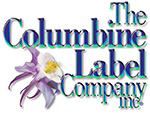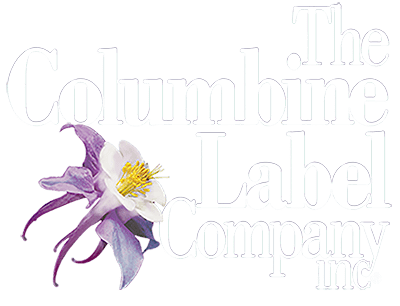As many business owners know, pricing is a key element in your business. How do I determine my price and what will the market bear are two questions that every business must answer. So what goes into pricing – for a label company there are many elements that the general consumer might not know about how a quote is determined. And when a business finally reaches the threshold of moving from DIY labels for their product to professionally printed product labels you don’t want them to have “sticker shock” – Ba dum tss! If you have been trying to compare prices for your new product labels, you may have found it difficult to find, or uncommon for companies to provide instant or online quotes. Why is that? In this blog, we will discuss the elements of a custom product label quote.
Elements of a Custom Product Label Quote
Material Use
Substrate
At Columbine Label our digital presses use 13″ wide material. The presses cannot print to the edge of the material so the usable width of the label stock is 12.375″ (height on the instant label quoter). The maximum label length is not determined by our material but instead determined by our die cutting which can cut a label up to a max of 17.7″ (width on the instant label quoter). Each label must also be separated from the other labels by a minimum of 1/8″ (0.125″) on each side. So, the game is to fit as many labels as possible inside of those restrictions. The more labels that fit, the less material is wasted as scrap, and the more cost effective your labels become.
Labels are not typically designed for how they are printed. They are designed for the container of your product. So, sometimes labels do not maximize their material use, but a good design team and pre press team should make suggestions so that you can maximize your labels and minimize your cost.
The absolute maximum height of your custom product label to minimize your material use is 6.125″ (6&1/8″). Why? Referring to the first paragraph in this section, this is how the math works out. Label 1 height 6.125 + label 2 height 6.125 + the gap between the labels 0.125 = maximum print width 12.375″. So what do you do if you want a label that is say 6.25″ (6&1/4)? You have two options. 1. You can make the decision to make your label a height that is 1/8″ smaller, this is the most cost effective. Or 2. You can have a label that is 6.25″ in height, but because it is an inefficient height it can only be run 1 up instead of 2 up. This means to get the same number of total labels you will have to use almost double the length of material. This increases material use and time to print the labels. This efficiency/material use factor is a key driver is product label quotes.
Ink
Not only does the amount of material make a difference when determining your custom product label quote, but the ink cost is also something to take into consideration. Many digital presses print up to 7 colors, Cyan, Yellow, Magenta, Black, Orange, Violet, and White. Using the first four on the list Cyan, Yellow, Magenta, and Black is what is referred to as process printing. Process printing can accurately create colors for about 68% of the Pantone Color Gamut. If your design needs a color that is not covered in that 68%, printers will use what is called extended gamut printing and include the use of Orange and Violet inks. This addition covers about 98% of the color gamut. White ink is used on substrates (label materials) that are non white in what is called a white layer.
So, why do the number of inks matter? Firstly, because there is a material cost associated with using more ink. Second, because of press speed. Labels printed using process printing print much faster than extended gamut. Additionally, white ink and associated drying times for white ink slow the press substantially, leading to a more expensive produce label quote.
Material Type
The options are (almost) limitless. Our instant quoter provides options for four material types and two different liners, but that doesn’t come close to all that we can offer. The vast majority of custom product labels are printed on BOPP (Biaxially-Oriented (BO) Polypropylene (PP)). This is the most cost effective and readily available choice for a product label quote. Other materials include paper, wine stocks, other types of film, recycled papers and stocks. One of our label experts can help you determine what is right for your project. Need a specialty material – no problem, but it is certainly a factor when determining a custom product label quote.
Shape
The main factor in how shape impacts your custom product label quote is related to material use. Section 1 Material Use – Substrate outlines how that works. The other way that shape can impact the price of your label is through die charges. Labels are cut into their shape using a special tool called a die. A die is a flexible piece of metal tooled specifically to cut out the label shape, but not cut all the way through the liner. Dies can be unique to your label or come in more common sizes – such as beer labels. If your product labels are a special shape, unique to your brand and your product, you will likely have a one time die charge to purchase the special tool used for your shape. You will not incur a die charge on a second order of the same labels or labels that use the die you have purchased. You will also not incur a die charge if the die is already in our die catalog. Common sizes of squares, rectangles, circles, ovals, and more are already available for use and do not require a die charge. If your label requires a new die, you will either need to purchase that die, or in some cases there is a similarly sized die that could be used if you are open to slightly changing the size of your label. Our label experts can help you determine if that is a possibility for your project.
Quantity and Versions
How many labels do you want? 500, 5,000, 500,000 quantity of labels will impact your custom product label quote. We only quote work that is greater than 250 labels. We do this because it is inefficient for our machines to run quantities under this amount. Low quantities produce a lot of waste compared to the amount of finished labels. Similarly to buying in bulk, buying more labels will typically bring your price per label down. This is because the cost of setting up the press is spread out thinner and thinner to each label produced.
Number of versions is also a factor. If you have three label versions – different art, but they are the same size, shape, and material, these labels can be printed together. This increases efficiency, which results in a better price. So, even if you only 100 labels of each product, the total can be counted as 300, if the conditions above are met. Ask our label experts if your labels can be combined for this combo pricing.
Special Processes
Specialty processes can also impact your custom product label quote. Hot Stamp also called Foil Stamp or Embossing are examples of popular embellishment options that require a specialty process. These two processes are popular particularly for wine and spirits companies, but for other products as well. There are several reasons for the expense associated with Hot Stamping and Embossing. 1. Special flat bed dies are required for the stamp. 2. Additional material in the form of the foil itself. 3. Hot Stamping and embossing are slow processes, it takes more time in die cut than an order without Hot Stamping or Embossing and based on the specifics of the job, it may require multiple passes through the die cutting equipment in order to achieve the desired look. If you are wondering if there are alternatives to Hot Stamp you are in luck! Our Blog post Hot Stamp or Silver BOPP describes an alternative to Hot Stamping.
Overhead and Profit
No business can remain in business without overhead and profit. What does overhead include? Overhead includes but is not limited to the following: accounting fees, advertising, insurance, interest, legal fees, labor burden (wages, taxes, workers comp, benefits), rent, equipment upkeep, repairs, office supplies, taxes, telephone bills, and utilities. Every business needs to cover these costs or they will cease to remain in business. Profit, yes I admit it, we are a for profit company (like all companies that are not a 501c3). What do we do with that profit! 1. We have a profit sharing incentive so all employees can participate in the growth of Columbine Label. 2. We invest it – in new equipment and new resources to grow the company. 3. We save it – in months where we did not profit we used previous profits to cover overhead and make sure everyone was paid. Profit has been made into a villain, but I assure you every business needs profit to grow and that profit margin is baked into your label quote.
*Blog is intended to inform the reader on label quote basics. Additional fees may apply depending on project type.


